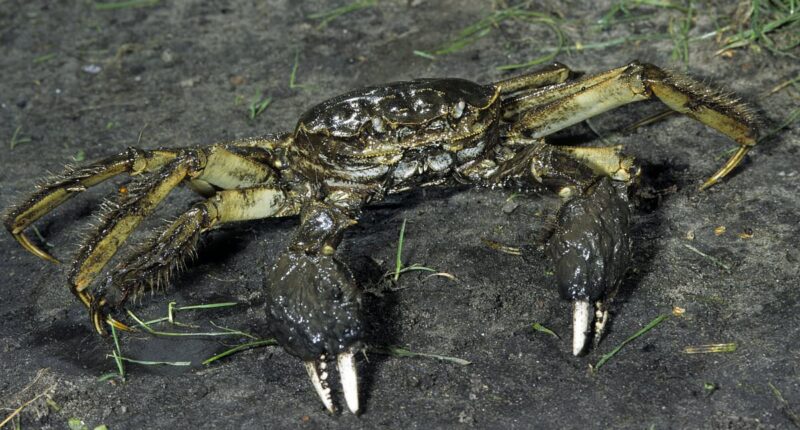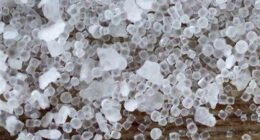In the Pacific Northwest, a highly invasive crab species with the ability to climb 13-foot concrete barriers has been observed, raising concerns among wildlife officials about potential harm to the environment and infrastructure.
On April 22, a Chinese mitten crab was caught by a commercial fisherman in the Lower Columbia River, just south of the border with Washington state, marking the first sighting of this species in the region, as reported by the Oregon Department of Fish and Wildlife.
‘Chinese mitten crabs have not been confirmed in the Pacific Northwest until now,’ the department wrote in a Thursday press release.
Wildlife officials noted that the highly invasive species ravaged the San Francisco Bay area three decades ago.
‘Although uncommon in Oregon, mitten crabs have previously caused significant ecological and infrastructural damage in and around San Francisco Bay during the peak of their population in the late 1990s,’ stated the department.
Experts speculate that the crab, a large male, may have been illegally introduced into the river either by a person or through ballast water – fresh or saltwater held in the ballast tanks and cargo holds of ships – from a passing ship.
Chinese mitten crabs, an invasive species native to East Asia, have been steadily spreading across the US since the 1980s, with the first established population appearing the San Francisco Bay.

The alarming discovery was made on April 22 when a commercial fisherman caught a Chinese mitten crab in the Lower Columbia River (pictured), just south of the Washington state border

Wildlife officials noted that the highly invasive species ravaged the San Francisco Bay area three decades ago. Pictured: Chinese mitten crab
The Smithsonian says that the crabs have since expanded to the East Coast, with recent sightings in New York raising fresh concerns, CBS News reported.
Named for their distinctive, hairy, mitten-like claws, Chinese mitten crab range in color from brownish-orange to greenish-brown, according to OregonLive.com.
Unlike native crab species, the East Asia-native species has distinctive markings set with four spines on each side and a noticeable notch between between their eyes, according to wildlife officials.
The US Bureau of Reclamation reports that the invasive crabs are capable of scaling concrete structures up to 13-feet high, further fueling fears about their potential impact on local ecosystems and infrastructure.
‘Mitten crabs can also pass through lock systems and possibly climb fish ladders, or leave the water and walk around barriers where the terrain is suitable,’ the bureau says.
The invasive Chinese species have been known to cause signifigant disruptions, including stealing fishing bait, damaging gear and obstructing power plant cooling systems, CBS reported.
Their burrowing activity along riverbanks also heightens flood risks by destabilizing the terrain and accelerating erosion.
While these crabs primarily inhabit freshwater throughout most of their lives, they require saltwater to reproduce, according to the Oregon Department of Fish and Wildlife.

Unlike native crab species, the Chinese mitten crab has distinctive markings set with four spines on each side and a noticeable notch between between their eyes

Named for their distinctive, hairy, mitten-like claws, Chinese mitten crab range in color from brownish-orange to greenish-brown

In the meantime, authorities are encouraging the public to be vigilant and report any sightings of the distinctive creatures to the Oregon Department of Fish and Wildlife or the Oregon Invasive Species Council. Pictured: Across the Columbia River in Washington
‘Newly hatched larvae are in open saltwater in bays and estuaries and fully molted juveniles are found in brackish and freshwater areas within a few miles upstream of saltwater,’ the department says.
Now, Oregon wildlife biologists are collaborating with the Department of Fish and Wildlife and NOAA – National Oceanic and Atmospheric Administration – to assess whether additional mitten crabs are present in the area.
Officials have announced plans to establish trap lines and collect water samples ‘to look for environmental genetic markers specific to the mitten crab.’
In the meantime, authorities are encouraging the public to be vigilant and report any sightings of the distinctive creatures to the Oregon Department of Fish and Wildlife or the Oregon Invasive Species Council.
‘It is important to correctly identify this species and report it to your local ODFW office with the location found,’ the Oregon Department of Fish and Wildlife said.
Anyone who catches a Chinese mitten crab is asked to take photos and report it with the location to the Oregon State Police TIPS Line (call 1-800-452-7888 or *OSP or *677 from a mobile phone or email [email protected]).

















